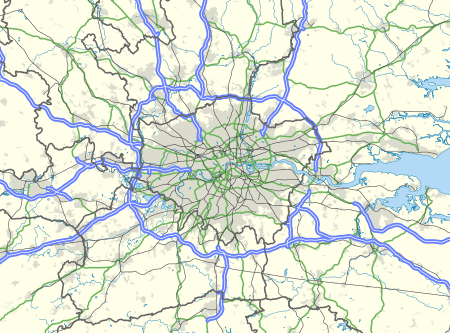High Wycombe
High Wycombe, often referred to as Wycombe (/ˈwɪkəm/ WIK-əm),[1] is a large market town in Buckinghamshire, England. Lying in the valley of the River Wye surrounded by the Chiltern Hills, it is 29 miles (47 km) west north-west of Charing Cross in London; this information is also engraved on the Corn Market building in the centre of the town. It is also 13.2 miles (21.2 km) south-south-east of the county town of Aylesbury, 23.4 miles (37.7 km) southeast of Oxford, 15.4 miles (24.8 km) north-east of Reading and 7.7 miles (12.4 km) north of Maidenhead. According to the ONS official estimates for 2016, High Wycombe has a population of 125,257 and it is the second largest town in the county of Buckinghamshire after Milton Keynes. High Wycombe Urban Area, the conurbation of which the town is the largest component, has a population of 133,204.
| High Wycombe | |
|---|---|
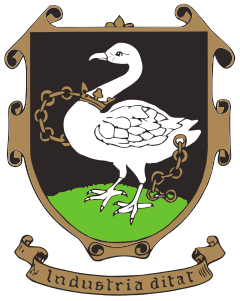 Coat of arms of High Wycombe. Motto: Industria ditat (Industry enriches) | |
High Wycombe Guildhall, located at the end of the High Street | |
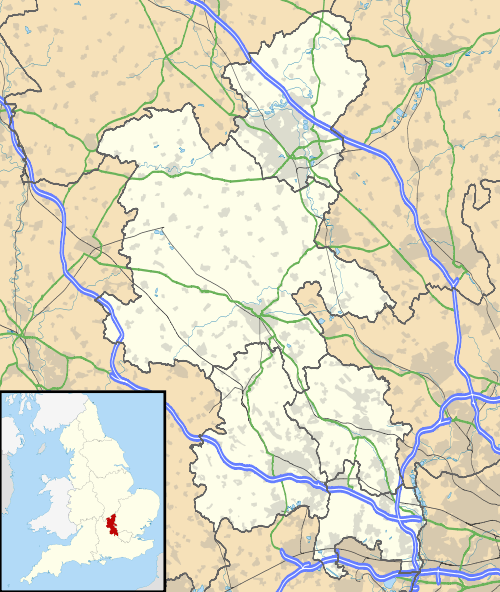 High Wycombe Location within Buckinghamshire | |
| Population | 125,257 |
| OS grid reference | SU867929 |
| Unitary authority | |
| Ceremonial county | |
| Region | |
| Country | England |
| Sovereign state | United Kingdom |
| Post town | High Wycombe |
| Postcode district | HP10-15 |
| Dialling code | 01494 |
| Police | Thames Valley |
| Fire | Buckinghamshire |
| Ambulance | South Central |
| UK Parliament | |
| Website | www |
High Wycombe is mostly an unparished area. Part of the urban area constitutes the civil parish of Chepping Wycombe, which had a population of 14,455 according to the 2001 census – this parish represents that part of the ancient parish of Chepping Wycombe which was outside the former municipal borough of Wycombe. Wycombe is a combination of industrial and market town, with a traditional emphasis on furniture production. There has been a market held in the High Street since at least the Middle Ages. The market is currently held on Tuesday, Friday and Saturday.[2]
History
Early history
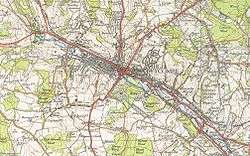
The name Wycombe appears to come from the river Wye and the old English word for a wooded valley, "combe", but according to the Oxford English Dictionary of Place-Names the name, which was first recorded in 799–802 as "Wichama", is more likely to be Old English "wic" and the plural of Old English "ham", and probably means "dwellings"; the name of the river was a late back-formation.[3] Wycombe appears in the Domesday Book of 1086 and was noted for having six mills. The town once featured a Roman villa (built 150–170 AD)[4] which has been excavated three times, most recently in 1954. Mosaics and a bathhouse were unearthed at the site on what is now the Rye parkland. High Wycombe was the home of 19th-century Prime Minister Benjamin Disraeli.[5]
The existence of a settlement at High Wycombe was first documented as 'Wicumun' in 970. The parish church was consecrated by Wulfstan, the visiting Bishop of Worcester, in 1086. The town received market borough status in 1222, and built its first moot hall in 1226, with a market hall being built later in 1476.[6]
The 1841 census reports the population that year was 3,184.[7]
Trade and industrial development
High Wycombe remained a mill town through Medieval and Tudor times, manufacturing lace and linen cloth. It was also a stopping point on the way from Oxford to London, with many travellers staying in the town's taverns and inns.[6]
The paper industry was notable in 17th and 18th century High Wycombe. The Wye's waters were rich in chalk, and therefore ideal for bleaching pulp. The paper industry was soon overtaken by the cloth industry.
Wycombe's most famous industry, furniture (particularly Windsor chairs) took hold in the 19th century, with furniture factories setting up all over the town. Many terraced workers' houses were built to the east and west of town to accommodate those working in the furniture factories. In 1875, it was estimated that there were 4,700 chairs made per day in High Wycombe. When Queen Victoria visited the town in 1877, the council organised an arch of chairs to be erected over the High Street, with the words "Long live the Queen" printed boldly across the arch for the Queen to pass under. Wycombe Museum includes many examples of locally made chairs and information on the local furniture and lace industries.
The town's population grew from 13,000 residents in 1881 to 29,000 in 1928. Wycombe was completely dominated socially and economically by the furniture industry and, consequently, there was considerable unemployment and social problems when the industry declined in the 1960s.
20th century
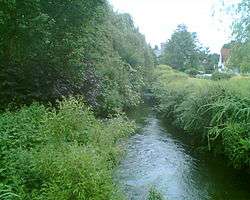
By the 1920s, many of the housing areas of Wycombe had decayed into slums. A slum clearance scheme was initiated by the council in 1932, whereby many areas were completely demolished and the residents rehoused in new estates that sprawled above the town on the valley slopes.[8] Some of the districts demolished were truly decrepit, such as Newland, where most of the houses were condemned as unfit for human habitation, with sewage pouring down the street and people sharing one room in cramped quarters of subdivided flats. However, some areas such as St. Mary's Street contained beautiful old buildings with fine examples of 18th and 19th century architecture.[9]
From 1940 to 1968 High Wycombe was the seat of the RAF Bomber Command. Moreover, during the Second World War, from May 1942 to July 1945, the U.S. Army Air Force's 8th Air Force Bomber Command, codenamed "Pinetree", was based at a former girls' school at High Wycombe. This formally became Headquarters, 8th Air Force, on 22 February 1944.[10]
In the 1960s the town centre was redeveloped. This involved culverting the River Wye under concrete and demolishing most of the old buildings in Wycombe's town centre. Two shopping centres were built along with many new multi-storey car parks, office blocks, flyovers and roundabouts. On the open area known as Frogmoor (or Frogmore) the original cast-iron fountain and some Georgian buildings have been torn down.
Modern-day High Wycombe
High Wycombe comprises a number of suburbs including Booker, Bowerdean, Castlefield, Cressex, Daws Hill, Green Street, Holmers Farm, Micklefield, Sands, Terriers, Totteridge, Downley and Wycombe Marsh, as well as some nearby villages: Hazlemere and Tylers Green. Particular areas in the suburbs of Castlefield, Micklefield, Terriers and Totteridge have high levels of deprivation compared to the rest of the urban area.
Although situated in the county of Buckinghamshire, which is one of the most affluent parts of the country,[11] Wycombe contains some considerably deprived areas.[12] In 2007, a GMB Union survey ranked the Wycombe district as the 4th dirtiest in the South East and the 26th dirtiest in the whole UK.[13][14] The survey found litter on 28.5% of streets and highways. Data for the survey were taken from the Government's 2005/06 Audit Commission.
The town has undergone major redevelopment, including development of the town's existing shopping centre, completion of the Eden Shopping centre, and redevelopment of the Buckinghamshire New University with a large student village and new building on Queen Alexandra Road.[15]
These developments prompted the building of larger blocks of flats, a multimillion-pound hotel in the centre, and a Sainsbury's store on the Oxford road next to the Eden shopping centre and bus station.
Demography
High Wycombe's population figure differs with the varying definitions of the town's area. For the town proper (that is, without the suburbs) it is often given as 77,178. However, Hazlemere is now regarded as part of Wycombe, which makes the population of High Wycombe town 92,300. The High Wycombe urban area (with some surrounding settlements) has a population of 133,204.[16] Which is approximately a 13% increase on the 2001 population of 118,229.[17]
| Place | Population (2001 census) | Population (2011 census) |
| Bourne End/Flackwell Heath | 12,795 | |
| Cookham | 5,304 | 5,108 |
| Great Kingshill | 2,452 | 1,761 |
| Hazlemere/Tylers Green | 20,500 | |
| High Wycombe | 77,178 | 120,256 |
| Walters Ash | 3,853 | |
| Hughenden Valley | 1,915 | |
| TOTAL | 118,229 | 133,204 |
Notes:
- Hazlemere/Tylers Green and Bourne End/Flackwell Heath were included as part of the High Wycombe subdivision in the 2011 census.
- Hughenden Valley and Walters Ash were separate urban areas in the 2001 census.
- The Walters Ash subdivision includes the village of Naphill.
According to the 2011 census, the parliamentary constituency of Wycombe consists of approximately 108,000 people.[18] White British people comprise 67.2% of the constituency's population. The next largest group in the constituency are Pakistanis, who comprise 11.8% of the population.[18] 52.3% of the population are Christians, 24% possess no religion and 13.4% are Muslim.[18]
65.7% of the constituency own their own home either outright or with a mortgage. 14.6% are social renters and 17% are private renters.[18] 15.8% of households in the constituency do not own an automobile.[18]
Politics
Wycombe's political history extends back to 1295. The Wycombe Constituency has continuously elected Conservative Members of Parliament since 1951.
Notable MPs
High Wycombe has been home to two Prime Ministers:
- the Earl of Shelburne lived at what is now Wycombe Abbey (and was also MP for the town)
- Benjamin Disraeli, who lived at nearby Hughenden Manor, was defeated as an independent candidate in 1832, but won election in 1868 and 1874-1880 as a Conservative. Disraeli made his first political speech in Wycombe, from the portico over the door of the Red Lion Hotel on the High Street (now Iceland/Bargain buys).
High Wycombe was also in the constituency represented by John Hampden (1594-1643), a leading MP and Parliamentarian commander who was killed in action during the Wars of the Three Kingdoms.
The town is currently represented by Conservative MP Steve Baker. He is chairman of the eurosceptic European Research Group and was a junior minister in the Department for Exiting the European Union from 2017 to 2018. In July 2018, Baker resigned alongside Brexit Secretary David Davis and Foreign Secretary Boris Johnson in opposition to the Chequers plan proposed by Prime Minister Theresa May.
Local government
The constituency is strongly Conservative outside High Wycombe town; in the town itself the political landscape is more mixed with some wards represented by independent, Labour and Liberal Democrat councillors.
Weighing the mayor
A ceremony carried out in the town since 1678[19] involves the weighing of the mayor. At the beginning and end of each year of service, the mayor is weighed in full view of the public to see whether or not he or she has gained weight, presumably at the taxpayers' expense. The custom, which has survived to the present day, employs the same weighing apparatus used since the 19th century. When the result is known, the town crier announces "And no more!" if the mayor has not gained weight or "And some more!" if they have. Their actual weight is not declared.[20]
Education
Buckinghamshire is one of the few counties that still has a selective educational system based on the former tripartite system. Pupils in their last year at primary school take what is commonly known as the 11+ exam. Their score in this exam determines whether they are accepted into a grammar school or a secondary modern school.
Primary schools
Catchment area primary schools in High Wycombe[21]
- Ash Hill Combined School
- Beechview Junior School
- Booker Hill Combined School
- Castlefield Combined School
- Chepping View Combined School
- Hamilton Academy
- Hannah Ball School
- Highworth Combined School & Nursery
- High Wycombe Church of England Combined School
- Kings Wood Combined School
- Marsh Infants School
- Millbrook Combined School
- Oakridge Combined School
- St Michael's Catholic School (combined primary and secondary school)
- The Disraeli Combined School and Children's Centre
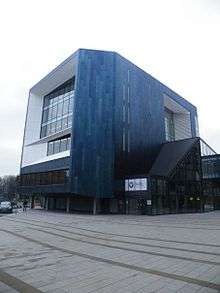
- West Wycombe Combined School
Secondary schools
- Cressex Community School
- Highcrest Academy
- John Hampden Grammar School
- St Michael's Catholic School (combined primary and secondary school)
- Royal Grammar School
- Wycombe High School
- Sir William Ramsay School
- Holmer Green Senior School
Independent schools
- Crown House School[22]
- Godstowe Preparatory School
- Pipers Corner School
- Wycombe Abbey
Further and higher education
Amersham & Wycombe College is a further education college located near High Wycombe at Flackwell Heath, with campuses also at Chesham and Amersham. High Wycombe is home to the main campus of Buckinghamshire New University. It is located in the centre of the town on the former site of the High Wycombe College of Art and Technology. It received its university charter in summer 2007.
Media coverage
High Wycombe has been featured in the national media in recent years for a number of different reasons, including seasonal coverage of the local library's refusal to display a Christmas carol service poster[23] and other stories such as the triple shooting[24] of three young Asian men, a small-scale riot between feuding families and gangs in which knives, metal poles, and an axe were used[25] whilst a gunman sprayed bullets; and the shooting and murder of Natasha Derby at point-blank range in the middle of a busy dance floor at a town centre venue.[26][27]
The town appeared in national and international media after anti-terrorism raids were carried out across the town on 10 August 2006 as part of the 2006 transatlantic aircraft plot.[28] Five arrests were made at three different houses in the town's Totteridge and Micklefield areas. A small number of houses in High Wycombe were evacuated in Walton Drive, which is thought to be because one of the raided houses contained dangerous liquid chemicals.
A three-mile (4.8 km) no-flight zone over the town was ordered. Other raids and arrests were also made in East London and Birmingham.
King's Wood to the north of the town was cordoned off for four months to be searched by police, and many suspicious items were allegedly found including explosives, detonators, weapons and hate tapes. Other woodlands in the Booker area of the town and the M40 at High Wycombe as well as nearby woods were also under observation. Explosives officers were called to the motorway, as were forensic officers. A lane of the motorway was closed as a precaution.
On 21 December 2009, heavy snowfall hit the town, paralysing its road network (which is mainly on steep hills), and causing major disruption to refuse services for several weeks. Staff and customers of the John Lewis department store were stranded overnight, leading to national news reports and interviews from GMTV and other radio stations on the morning of 22 December.[29]
Notable residents (past and present)
Entertainment and the media
- Alexander Aze – child actor
- Colin Baker – actor who played the sixth incarnation of the Doctor in Doctor Who, and columnist for the Bucks Free Press.[30]
- Katy Brand - Comedian and writer.
- Mighty Boosh stars Noel Fielding and Dave Brown met when they attended Bucks New University in Wycombe. Julian Barratt then joined the group after Fielding scouted him performing in the Wycombe Swan theatre.[31]
- Judy Boucher – country and RnB singer originally from St Vincent.[32]
- Stevyn Colgan – author and artist.
- Giles Cooper, entertainment producer and promoter. Best known as Chairman of the annual Royal Variety Performance[33]
- James Corden – actor, comedian, writer, producer and television host.[34]
- Terry Cox – drummer, the Pentangle, David Bowie, Elton John, Charles Aznavour and many others.[35]
- Ian Dury – rock & roll singer and songwriter. He was educated at the Royal Grammar School.[36]
- Joanne Froggatt – British actress best known for her role as Anna Bates in Downton Abbey.
- Theo James – actor.
- Howard Jones – singer and songwriter.[37] He was educated at the Royal Grammar School.
- Jim Jones – former member of Thee Hypnotics, Black Moses and currently frontman of The Jim Jones Revue.[38]
- Alex Kew – actor and musician.[39]
- Eric Knowles – Antiques Roadshow presenter, currently lives in the town.[40]
- Sally Philips – comic actress.[41]
- Leigh-Anne Pinnock – member of girl band Little Mix, winners of The X Factor 2011.[42]
- Terry Pratchett – author, educated at John Hampden Grammar School.
- Charlotte Roche – British-born German television presenter, actress, singer and author in March 2008.[43]
- Laura Sadler – actress of Grange Hill and Holby City.[44]
- Dusty Springfield – singer.[45]
- Ian Stanley – keyboard player with rock band Tears for Fears.
- Aaron Taylor-Johnson – actor.[46]
- Colin Teague – film and television director.
- Sy Thomas – TV presenter, standup comedian and actor.[47]
- Frankie Vaughan – pop singer.[48]
- Young Guns – High Wycombe-based band.[49]
Sports
- Elliot Benyon – footballer with Wealdstone
- Dominic Blizzard – former footballer most recently with Plymouth Argyle.
- Simon Church – Welsh international footballer.[50]
- Matt Dawson – scrum-half for England rugby union team which won the Rugby World Cup in 2003. He was educated at the Royal Grammar School.[51]
- Luke Donald – former world no.1 golfer, educated at the Royal Grammar School.[52]
- Jack Goff – motor-racing driver, currently racing in the British Touring Car Championship
- Isa Guha – England Women's cricketer and Women's World Cup winner.[53]
- Jean Hawes - hockey player who received an MBE in 2007.
- Tom Ingram – motor-racing driver, currently racing in the British Touring Car Championship.[54]
- Mike Keen – former footballer and manager, winner of the League Cup in 1967.[55]
- Robbie Kerr – motor-racing driver.
- Phil Newport – former Worcestershire and England cricketer.[56]
- Tom Rees – England and London Wasps Rugby Flanker, educated at the Royal Grammar School.[57]
- Nicola Sanders – Olympic athlete.[58]
- Wilf Slack – Middlesex and England cricketer.[59]
- Christian Wade – England Wasps player, educated at the Royal Grammar School and raised in High Wycombe.[60]
Other fields
- Heston Blumenthal – celebrity chef and owner of the Michelin 3-star Fat Duck restaurant. He was born in the town and educated at John Hampden Grammar School.[61]
- Mitford family – aristocrats.[62]
- Roger Scruton – philosopher, educated at the Royal Grammar School.
- Geoffrey De Havilland – aviation pioneer and aircraft engineer. Born at Terriers House.[63]
- Benjamin Disraeli – 19th century prime minister, politician, and literary figure.[64]
- Eric Gill – sculptor and print maker.[65]
- Karl Popper – philosopher.[66]
- Jean Shrimpton – supermodel.[67]
- Heather Stewart-Whyte – supermodel.
Transport
Road
The town's nearest motorway is the M40, which has two junctions serving Wycombe: junction 3 for Loudwater and High Wycombe (east) and junction 4 at Handy Cross roundabout for central Wycombe, Marlow and Maidenhead. Junction 4 is a major interchange between the M40 and A404 trunk road which provides a link to the M4. It had suffered from heavy congestion but was improved by the Highways Agency in 2006.[68] Junction 3 is restricted; only traffic going towards and coming from London can join and exit respectively. The M25 and M4 are also fairly close.
Other roads include the A404 towards Marlow and Amersham; the A4010 towards Aylesbury; and the A40 towards Beaconsfield and Oxford.
Bus
High Wycombe Eden bus station is served by Arriva Shires & Essex and Carousel Buses. Major destinations include Reading, Slough, Aylesbury, Heathrow Airport, Maidenhead, Watford, Chesham, Uxbridge and Berkhamsted. In November 2013, First Berkshire & The Thames Valley added express route X9 to Maidenhead to its existing X74 express to Slough.[69] Other operators serving the town include Redline, Red Rose and Z&S Buses.
High Wycombe is served by one of Buckinghamshire's Rainbow Routes network of services. Originally piloted in Aylesbury, its success led to a network being set up in the town. Rainbow Routes is a partnership between Buckinghamshire County Council and local operators Arriva Shires & Essex and Carousel Buses. They provide regular services within the town and its suburbs, and this network includes:[70]
- Pink Route 30 – Arriva Shires & Essex, every 15 minutes to Downley
- Green Route 31 – Arriva Shires & Essex, every 15 minutes to Penn and Hazlemere
- Blue Route 32 – Arriva Shires & Essex, every 15 minutes to Micklefield and Booker
- Red Route 33 – Arriva Shires & Essex, every 12 minutes to Totteridge and Castlefield
- Purple Route 35/36 – Carousel Buses, every 30 minutes to Flackwell Heath
- Orange Route 39 – Carousel Buses, every 20 minutes to Hicks Farm
The town also has a Park and Ride facility located in Cressex, near junction 4 of the M40. Services run to the town centre, passing the railway station, it also serves Wycombe Hospital and Hicks Farm Rise.[71]
Coach
The only coach service to enter the town centre is National Express route 737 service from Oxford to Stansted Airport.[72] High Wycombe Coachway close to junction 4 of the M40 is served by National Express services to destinations across the United Kingdom. It opened in January 2016.[73][74] It is linked to the town by local buses and by park and ride buses.[75]
Rail
The town is served by High Wycombe railway station on the Chiltern Main Line, with services operated by Chiltern Railways from London Marylebone to Aylesbury, Oxford, Stratford-upon-Avon, Birmingham Snow Hill and Kidderminster.[76][77] The station is the busiest in South Buckinghamshire. Express services travel to London in 23 minutes, slower trains take up to 45 minutes.
The Wycombe Railway ran from High Wycombe to Maidenhead on the Great Western Main Line through Loudwater and Bourne End. However, it was a victim of the Beeching cuts with the Wycombe to Bourne End section closed in May 1970. The southern section remains open as part of the Marlow Branch Line.[78]
Air
Heathrow Airport is the nearest international airport, located just outside Buckinghamshire in Hillingdon. Wycombe Air Park on the southern edge of the town is popular with learning pilots and gliders.
Facilities and places of interest
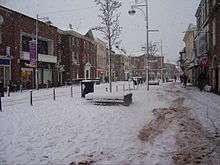
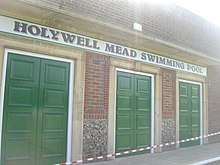
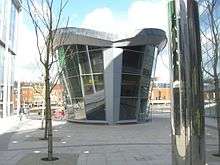
There are two shopping centres: the Eden Centre which spreads from the High Street under the Abbey Way flyover to the south of the A40; and the Chilterns Centre, which is located between Queen's Square and Frogmoor to the north. The High Street (pedestrianised in the early 1990s) has a number of 18th and 19th century buildings, and ends at the colonnaded Guildhall that was built in 1757 by Henry Keene, funded by the Earl of Shelburne, and renovated in 1859. [79] The small octagonal-shaped Cornmarket opposite, known locally as the Pepper Pot, was rebuilt to designs by Robert Adam in 1761. The large parish church of All Saints[80] was founded in 1086, enlarged in the 18th century and extensively restored in 1889. There is a large, well equipped theatre, the Wycombe Swan, which hosts many acts and shows before or after their appearance in the West End.
In March 2008, a new development of the town centre was completed. This included the demolition and movement of the bus station and the brand new Eden Shopping Centre, with 107 shops, new restaurants, a large bowling alley and cinema and new housing. The old Octagon shopping centre was connected to the new development. The complex, one of the largest in the country, is seen as a major milestone in the regeneration of the town.
There are out-of-town retail outlets in the suburbs of Cressex (including John Lewis, Asda and TGI Fridays), Loudwater (including Tesco, Dunelm and Homebase), and Wycombe Marsh, where there is a small retail park of shops and restaurants including Hobbycraft, PC World, Pets at Home, Argos and M&S Simply Food. Desborough Road provides a secondary shopping area with more independent traders and a number of takeaways.
To the east of the town centre is the extensive Rye park (and river) and dyke. The park had an outdoor swimming pool, which closed in 2009. The pool has now reopened together with a new gym and has been renamed as the Rye Lido.[81] The River Wye winds through the green space, which is particularly attractive during the summer. Wycombe's yearly "Asian Mela" takes place on the Rye. There is a museum on Priory Avenue in the town centre situated on its own grounds and including a Norman castle mound. The theme of the museum is the history of Wycombe, with the main focus being the chair industry.
Wycombe town centre is home to many public houses and bars, especially in the Frogmoor area. The White Horse pub appeared on 'Britain's toughest pubs'.[82]
The town features the old Wycombe Summit,[83] formerly the largest dry ski slope in England, before it was destroyed in a fire. Construction work was due to start in September 2008, on what would have become England's third and largest indoor real snow ski centre. In May 2009, it was announced that construction would be delayed due to 'difficulties getting a planning consent amendment.'[83] As of 31 January 2012 it was announced that the site was up for sale.[84]
Hughenden Manor borders the northern urban fringe of High Wycombe, approximately 2 miles (3 km) from the centre of town. Built in the Regency period, the architecturally appealing house was also home to Benjamin Disraeli for three decades in the mid-19th century. The three-floor mansion is situated in its own extensive grounds with beautifully landscaped gardens which back into the attractive Chiltern countryside. It is open to the public all year round as an historical attraction.
The local council maintains a landmark statue of a red lion above the former Woolworth's store on the High Street. Its significance dates back to when the building was the Red Lion Hotel. Since its installation, the lion has been replaced several times and has had to undergo extensive repair due to damage from both the elements and human interference. Another notable landmark is the ruins of the Hospital of St John the Baptist,[85] which is located on Easton Street, just east of the town centre opposite the Rye parkland, and dates to the 12th century. The stone structure is one of the very oldest in Wycombe, and is said to contain stone used from the Roman villa on the Rye.
The site of the ancient Desborough Castle is situated between the Desborough and Castlefield suburbs of the town, and provides their names.
Industry
Wycombe was once renowned for chairmaking (the town's football team is nicknamed the 'Chairboys') and furniture design remains an important element of the town's university curriculum, Buckinghamshire New University. Among the best known furniture companies were Ercol and E Gomme. The River Wye runs through the valley, where beech trees were cut down by the chair industry to forming the town centre (circa 1700), with housing along the slopes (some areas are still surrounded by woods). The town was also home to the worldwide postage stamp and banknote printer Harrison and Sons. More recent industries in the town include the production of paper, precision instruments, clothing and plastics. Many of these are situated in an industrial area of the Cressex district, southwest of the town centre. The two largest sites belong to the companies Swan (tobacco papers, filters and matches) and Verco (office furniture), who until 2004 sponsored the local football team, Wycombe Wanderers.
Wycombe's industrial past is reflected on the town's motto Industria ditat, "Industry enriches".[86] The motto can be found on town crest and Mayor's badge of office.[87]
Local attractions
Recreation
Booker Gliding Club and two flying schools at Wycombe Air Park, the modern name for Booker Airfield, to the south of the M40 motorway on the western edge of the town. Many of the replica aircraft used in the film industry, for example in films such as Those Magnificent Men in their Flying Machines, Aces High and The Blue Max were built and flown there. There is a restaurant (The Pad) with outdoor picnic tables that is open to visitors beneath the control tower. Wycombe Air Park is one of the busiest general aviation airfields in the UK. The Air Park is also home to Buckinghamshire Squash and Racketball Club.
There is also a large leisure centre to the south of town at the top of Marlow Hill. Many sporting activities take place here and there is an Olympic-size swimming pool, which can be split into two 25-metre pools by raising and lowering a wall. The leisure centre was designed by renowned architect John Attenborough. It will be demolished to make way for other developments once a new sports centre is completed on the site in 2015/16.[88]
After a £2 million investment into the former Holywell Mead open swimming pool site in the town's Rye Park, a new sports & leisure facility was reopened in the summer of 2012.[81]
Housing
A new experimental scheme to knock down old council flats in Micklefield and replace them with housing association properties was approved by John Prescott in 2003 after overwhelming approval by council residents. There are many different housing areas within the town, some of which such as the Castlefield district have gained a bad reputation for crime and drug-related problems.
The town is a diverse mixture of large council estates built in the 1930s, 1950s and 1960s that sprawl up the valley sides, compact Victorian terraces in the bottom of the valley to the east and west of town, and desirable areas for wealthy commuters. The Amersham Hill area is noted for its large period properties and leafy streets. Recent developments are showing a tendency towards blocks of flats, and developers are mainly making use of brownfield sites.
Sport
The town's football team, Wycombe Wanderers, play at Adams Park, named after Frank Adams who donated the old Loakes Park ground to the club. They relocated to their current stadium in 1990. They are currently members of The Championship and have been members of the Football League since 1993 when they were promoted as champions of the Football Conference. Since then they have enjoyed two notable cup runs (to the semi-finals of the FA Cup in 2001 and the Football League Cup in 2007) and three recent promotions from the fourth tier of the English league to League One (via the playoffs in 1994 and automatically in 2009, 2011 and 2018). They have been managed by a number of high-profile football figures, including Martin O'Neill, Lawrie Sanchez and Tony Adams. Their current manager is former Queens Park Rangers player/manager Gareth Ainsworth.
The Wasps rugby union team has also played at Adams Park for home games between the 2002–03 season and December 2014, the club's most successful spell. Nicola Sanders, a female track and field athlete who is current European Indoor Champion and world outdoor silver medallist for 400 metres, and also current world bronze medalist for outdoor 4 × 400 metres relay, is a High Wycombe native.
Closest cities, towns and villages
Amersham 7 miles, Aylesbury 17 miles, Beaconsfield 5 miles, Marlow 4 miles, Maidenhead 9 miles, Oxford 26 miles, Reading 23 miles
Popular culture
High Wycombe is sometimes portrayed as a rather dull town where nothing much happens,[89] as in this exchange between Kenneth Horne and Kenneth Williams in Round the Horne,
KH: What _did_ you do in the war, Ken?
KW: I drove a bus in High Wycombe. They used to call us "The Ladies from Hell".
The town was mentioned several times in "The Lying Detective" episode of the Sherlock TV series,[90] much in the same key.
Black Mirror Season 2 Episode 3 was filmed at the Eden Centre in High Wycombe.
References
- "High Wycombe". Collins Dictionary. n.d. Retrieved 23 September 2014.
- https://www.visitbuckinghamshire.org/article/high-wycombe
- Eilert Ekwall, 1960. The Concise Oxford English Dictionary of Place-Names. Oxford University Press. ISBN 0198691033.
- "Archived copy". Archived from the original on 25 May 2011. Retrieved 7 July 2010.CS1 maint: archived copy as title (link)
- Norman, Robert. "Benjamin Disraeli | prime minister of United Kingdom". Encyclopædia Britannica. Retrieved 9 August 2016.
- "High Wycombe : Historic Town Assessment Report Draft" (PDF). Buckscc.gov.uk. Archived from the original (PDF) on 22 February 2014. Retrieved 9 August 2016.
- The National Cyclopaedia of Useful Knowledge Vol.III, London, 1847, Charles Knight, p.899
- Beauman, Nicola (2009). The Other Elizabeth Taylor. Persephone. p. 175. ISBN 978-190-646210-9.
- "Timeline History of High Wycombe, Buckinghamshire". Visitoruk.com. Retrieved 9 August 2016.
- "Eighth Air Force". Web.archive.org. Archived from the original (DOC) on 30 June 2006. Retrieved 9 August 2016.
- "Archived copy" (PDF). Archived from the original (PDF) on 27 December 2013. Retrieved 8 September 2013.CS1 maint: archived copy as title (link)
- "Microsoft Word - Deprivation Fact File Final.doc" (PDF). Web.archive.org. Archived from the original (PDF) on 25 March 2009. Retrieved 9 August 2016.
- "Wycombe shamed in league table of filth (From Bucks Free Press)". Bucksfreepress.co.uk. 20 July 2007. Retrieved 9 August 2016.
- "Archived copy". Archived from the original on 21 February 2014. Retrieved 13 February 2014.CS1 maint: archived copy as title (link)
- "2011 Census - Built-up areas". ONS. Retrieved 1 July 2013.
- "Census 2001 Key Statistics - Urban areas in England and Wales KS01 Usual resident population released 17 Jun 2004". Ons.gov.uk. Retrieved 8 October 2011.
- http://data.parliament.uk/resources/constituencystatistics/census2011/census2011-Wycombe.pdf
- Lawrence Dunhill (16 March 2011). "Weights will not be read out at ceremony to save embarrassment (From Bucks Free Press)". Bucksfreepress.co.uk. Retrieved 9 August 2016.
- S. Roud The English Year: A month-by-month guide to the Nation's customs and festivals from May Day to Mischief Night. Penguin (2006).
- "A Guide to Primary Catchment Areas for September 2013 in High Wycombe Town" (PDF). Buckscc.gov.uk. Archived from the original (PDF) on 18 July 2013. Retrieved 9 August 2016.
- "Crown House Preparatory School High Wycombe". Crownhouseschool.co.uk. Retrieved 9 August 2016.
- Burkeman, Oliver (11 December 2006). "Religion (News),Communities (Society),Life and style,Politics,Local government UK (Society),Local politics (UK Politics),World news,Society,UK news,Christmas (Life and style),Luton (UK city)". The Guardian. London.
- "Three held in triple shooting". Liverpool Echo. Retrieved 9 August 2016.
- "Gun police lay siege to house after bloodbath. - Free Online Library". Thefreelibrary.com. Retrieved 9 August 2016.
- "Wild-West style shooting killed Natasha Derby, court hears". Getreading.co.uk. 4 September 2004. Retrieved 9 August 2016.
- "Mother in plea over reggae killer". BBC News. 8 September 2004.
- "'Airlines terror plot' disrupted". BBC News. 10 August 2006.
- "100 customers and staff stranded by snow sleep in John Lewis store". The Daily Telegraph. London. 22 December 2009.
- "Colin's Major role". Bbc.co.uk. Retrieved 2 January 2009.
- Farr, Simon (10 September 2011). "Noel Fielding talks the formation of The Mighty Boosh during Wycombe student days". Bucks Free Press. Retrieved 10 February 2012.
- "Judy Boucher". H and H Music. Archived from the original on 2 December 2011. Retrieved 8 September 2013.
- "Giles Cooper – biography". Royal Variety Charity. Retrieved 9 August 2016.
- Hattenstone, Simon (8 November 2008). "'I had a confidence problem – too much of it'". The Guardian. London. Retrieved 9 February 2012.
- "Pentangle: interview". Time Out London. Retrieved 8 June 2018.
- Balls, Richard (2001). The Life of Ian Dury: Sex, Drugs and Rock N Roll. Omnibus Press. p. 44. ISBN 0-7119-8644-4.
- "Archived copy". Archived from the original on 12 January 2009. Retrieved 1 January 2009.CS1 maint: archived copy as title (link)
- Perry, Andrew (16 June 2011). "Jim Jones Revue: Britain's last rock'n'rollers?". The Daily Telegraph. London. Retrieved 10 February 2012.
- Rann, Pete (25 June 2011). "Wycombe Highs: A Very Decent Interview With The Wutars". beatmagazine.co.uk. Archived from the original on 3 December 2012. Retrieved 10 February 2012.
- Cain, Rebecca (6 August 2010). "Restoration Roadshow on BBC2". Bucks Free Press. Retrieved 8 September 2013.
- "Archived copy". Archived from the original on 15 September 2012. Retrieved 1 January 2009.CS1 maint: archived copy as title (link)
- Phillips, Neil (24 December 2011). "Little Mix starlet Leigh-Anne Pinnock enjoys Wycombe homecoming party". Bucks Free Press. Retrieved 10 February 2012.
- Burke, Jason (25 May 2008). "Charlotte Roche". The Guardian. London. Retrieved 12 January 2010.
- "Laura Sadler : Biography". freewebs.com. Archived from the original on 6 July 2013. Retrieved 6 July 2013.
- "Devoted To Dusty: Return of the much-missed white lady of soul". The Independent. London. 25 February 2006. Archived from the original on 22 September 2011. Retrieved 8 September 2013.
- Cain, Rebecca (3 January 2010). "Another successful year for the Jackie Palmer Stage School and agency". Bucks Free Press. Retrieved 10 February 2012.
- "About". Sythomas.com. Archived from the original on 22 August 2016. Retrieved 9 August 2016.
- "Obituaries: 'Mr Moonlight' Frankie Vaughan dies". BBC. 17 September 1999. Retrieved 10 February 2012.
- "Young Guns". Aaamusic.co.uk. Retrieved 10 February 2012.
- "Leyton Orient | Simon Church – Profile". Orient.vitalfootball.co.uk. Retrieved 9 August 2016.
- Davies, Gareth A (4 February 2002). "Talking School Sport: RGS High Wycombe revel in succession of scrum-halves". The Daily Telegraph. London. Retrieved 4 May 2010.
- Feldberg, Alan (1 March 2011). "Wycombe's Luke Donald beats world number one". This is London. Archived from the original on 13 September 2012. Retrieved 9 February 2012.
- "Isa Guha Player Profile". ICC Women's World Cup. Archived from the original on 10 December 2011. Retrieved 8 September 2013.
- "Home". Tom-ingram.com. 4 June 2016. Retrieved 9 August 2016.
- Murphy, Alex (2 May 2009). "Mike Keen: Footballer who captained Third Division Queen's Park Rangers to League Cup victory in 1967". Independent. London. Retrieved 10 February 2012.
- Feldberg, Alan (2 July 2009). "RGS festival underway on Monday". Bucks Free Press. Retrieved 10 February 2012.
- "Tom Rees". Scrum.com. Retrieved 9 August 2016.
- Matt Jones. "Colin Jackson's Raise Your Game – Nicola Sanders". BBC. Retrieved 9 August 2016.
- "Middlesex County Cricket Club: Hall of Fame Profiles". Archived from the original on 12 February 2012.
- "RGS Former schooboys". The Royal Grammar school. Archived from the original on 21 July 2017.
- "JavaScript is disabled in your browser". Caterersearch.com. Retrieved 9 August 2016.
- "The Mitfords were good ol' High Wycombe gals (From This Is Local London)". Thisislocallondon.co.uk. 8 March 2001. Retrieved 9 August 2016.
- "Sports, leisure and tourism". Wycombe.gov.uk. Retrieved 9 August 2016.
- "Archived copy". Archived from the original on 20 October 2008. Retrieved 27 October 2008.CS1 maint: archived copy as title (link)
- "Font Designer — Eric Gill". Linotype.com. Retrieved 1 January 2009.
- "Rafe Champion on Malachi Hacohen, Karl Popper, The Formative Years, 1902–1945". The-rathouse.com. Retrieved 1 January 2009.
- Sale, Jonathan (28 August 1997). "PASSED/FAILED: Jean Shrimpton". The Independent. London. Retrieved 10 February 2012.
- "M40 Junction 4/A404 Handy Cross Junction Improvement". Archived from the original on 5 June 2011.
- Notices & Proceedings Office of the Traffic Commissioner 15 October 2013
- "Buses and trains - Buckinghamshire County Council". Rainbowroutes.co.uk. Archived from the original on 16 July 2016. Retrieved 9 August 2016.
- Home High Wycombe Park & Ride
- Route 737 timetable National Express
- Wycombe's coachway opens with 11 new NatEx services Coach & Bus Week 11 January 2016
- High Wycombe Coachway Archived 20 April 2018 at the Wayback Machine National Express
- New coach services to start in High Wycombe on Monday Bucks Free Press 11 January 2016
- High Wycombe Chiltern Railways
- High Wycombe National Rail Enquiries
- History Marlow - Maidenhead Passengers Association
- Page, William. "Parishes: High Wycombe Pages 112-134 A History of the County of Buckingham: Volume 3. Originally published by Victoria County History, London, 1925". British History Online. Retrieved 2 August 2020.
- "All Saints Church, High Wycombe - home". Allsaintshighwycombe.org. Retrieved 9 August 2016.
- Simon Farr. "Council boss hails Wycombe Rye Lido ahead of centre's opening (From Bucks Free Press)". Bucksfreepress.co.uk. Retrieved 9 August 2016.
- "Archived copy". Archived from the original on 22 February 2014. Retrieved 13 February 2014.CS1 maint: archived copy as title (link)
- "WYCOMBE SUMMIT England's longest ski & snowboard centre". Wycombesummit.co.uk. Retrieved 9 August 2016.
- Simon Farr (31 January 2012). "Wycombe Summit 'ski centre' site up for sale (From Bucks Free Press)". Bucksfreepress.co.uk. Retrieved 9 August 2016.
- Chisholm, Hugh, ed. (1911). . Encyclopædia Britannica. 28 (11th ed.). Cambridge University Press. p. 871.
- Pine, L.G. (1983). A dictionary of mottoes (1 ed.). London: Routledge & Kegan Paul. p. 113. ISBN 0-7100-9339-X.
- "Archived copy". Archived from the original on 24 July 2011. Retrieved 28 May 2011.CS1 maint: archived copy as title (link)
- Farr, Simon (21 May 2014). "Construction begins on new Wycombe Sports Centre". Bucks Free Press. Retrieved 17 January 2015.
- Helen and Neil Matthews on High Wycombe
- High Wycombe mentioned on Sherlock
External links
| Wikivoyage has a travel guide for High Wycombe. |
| Wikimedia Commons has media related to High Wycombe. |

